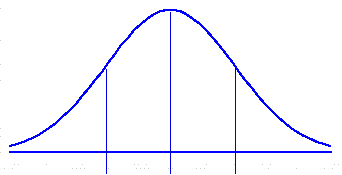Standard Error of the Difference Between the Means of Two Samples
The logic and computational details of this procedure are described in Chapter 9 of Concepts and Applications. |
The difference between the means of two samples, A and B, both randomly drawn from the same normally distributed source population, belongs to a normally distributed sampling distribution whose overall mean is equal to zero and whose standard deviation ("standard error") is equal to
square.root[(sd2/na) + (sd2/nb)]where
sd2 = the variance of the source population (i.e., the square of the standard deviation);na = the size of sample A;
nb = the size of sample B.
To calculate the standard error of any particular sampling distribution of sample-
 | ||||||||||||||
| -1sd | mean | +1sd | ||||||||||||
| <== | source population
|
|
| <==
| sampling | distribution
| | |||||||
| sd of source population |
| Home | Click this link only if you did not arrive here via the VassarStats main page. |
©Richard Lowry 2001-
All rights reserved.